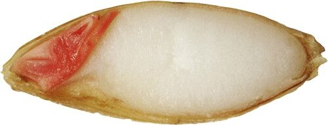
All about Malt
Posted by Kate Balchin on
As the 2022 barley harvest is now safely gathered in, we thought it might be nice to share a bit about what will happen to it next. As it goes through the malting process so it can become beer!
Firstly let’s look at the actual grain, pictured.
It’s divided into three parts:
- Embryo/Germ which will eventually grow into the roots and shoots of the new plants. (stained red for visualisation)
- Endosperm. Which is the food reserve (insoluble starch) to be used by the germ of the grain to grow.
- Husk. The grain covering, formed by two overlapping halves which protect the germ and endosperm.
The job of a maltster, (Muntons in our case), is to ‘modify’ the endosperm of the grain by hydration so that the starch can be released for subsequent use in the brewing process and then to halt the ‘modification’ using heat when the required germination level has been reached.
The malting process therefore follows this structure:
1. Intake/Drying
Arrival of the barley from the farmer into the maltings. Depending on the moisture levels in the barley grains at this time, it may then pass through a mechanical dryer to be left at a safe, storage moisture level, below 14%.
2. Storage & Screening
Storage to allow it to overcome the natural germ dormancy (6 weeks +) and screening to ensure an even sized grain distribution and remove any ‘foreign’ bodies, small stones etc.
3. Steeping
Once the grain is ready to undergo the malting process, it is first ‘steeped’ in water over a period of 2 - 3 days. This allows the maltster to raise the moisture content of the grain to around 46% without ‘drowning’ it. This allows the embryo within the grain to start to germinate.
4. Germination
Once the steeping is finished, the grain is transferred to a germination vessel. This is usually a large circular vessel with mechanical ‘turners/rakes’. The ‘green malt’ is left to continue germinating, with the addition of humidified air to prevent the grains drying out and mechanical turning using the rakes to prevent heat build up and keep the grains loose.
This stage can last between 4 - 6 days, depending on the final malt type required.
The germination allows enough enzyme production within the grain to allow breakdown of the cell walls of the starch in the endosperm but not enough so that the endosperm can be converted into a food source for the awakening roots.
5. Kilning
Once the ‘green malt’ is at the right germination level then it’s transferred into the kilns where the heat stops the germination process. The malt is first dried to stop the germination and then ‘cured’ at a higher temperature which stops all changes within the grain.
The temperature of the kiln is what determines the malt being made, so a lager malt would be kilned at a lower temperature than an ale malt for example.
6. Deculming
Once kilned, the malt is then passed through a machine known as a deculmer, which removes the ‘culm’ or small rootlets that have emerged from the kernels during germination. This ‘culm’ can then be used as animal feed.
7. Final Storage
Once deculmed, the malt is then stored and screened ready for dispatch to the brewer or distiller.
Share this post
- Tags: News
